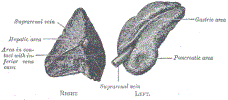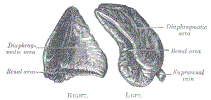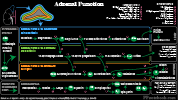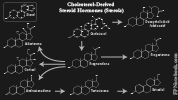Adrenal Anatomy, Adrenal Gland, Suprarenal Gland, Glandula Suprarenalis, Adrenal Medulla, Adrenal Cortex, Adrenal Gland Physiology
- Anatomy
- Anatomy Images
 Lewis (1918) Gray's Anatomy 20th ed (in public domain at Yahoo or BartleBy)
Lewis (1918) Gray's Anatomy 20th ed (in public domain at Yahoo or BartleBy) Lewis (1918) Gray's Anatomy 20th ed (in public domain at Yahoo or BartleBy)
Lewis (1918) Gray's Anatomy 20th ed (in public domain at Yahoo or BartleBy)
- Adrenal Gland is a flat, triangular organ that sits atop each Kidney
- Adrenal Gland is without ducts
- Adrenal Gland is divided into two distinct anatomical and physiologic components
- Adrenal Medulla is a modified sympathetic Ganglion releasing Sympathomimetic agents (epineprine, Norepinephrine)
- Adrenal Cortex generates inter-related steroid Hormones (mineralcorticoids, Glucocorticoids and androgens)
- Physiology
- Physiology Images
- Adrenal Medulla (sympathetic agent synthesis)
- See Sympathetic Nervous System
- See Alpha Adrenergic Receptor
- See Beta Adrenergic Receptor
- Inner structure of the Adrenal Gland
- Functions as a sympathetic Ganglion that releases Sympathomimetics in response to stressors
- Epinephrine
- Primary Adrenal Medulla released Catecholamine (more than Norepinephrine)
- Alpha Adrenergic Agonist Effects
- Vasoconstriction (increased Systemic Vascular Resistance and Blood Pressure)
- Increases Vital Organ Perfusion (myocardial perfusion, cerebral perfusion)
- Decreases Non-Vital Organ Perfusion (splanchnic, intestinal, renal and skin perfusion)
- Beta 1 Adrenergic Agonist Effects (at physiologic doses)
- Increases myocardial contractility
- Increases Heart Rate
- Beta 2 Adrenergic Agonist Effects
- Relaxes Bronchial Smooth Muscle (bronchodilation)
- Stimulates Gluconeogenesis, lipolysis and glycogen breakdown
- Norepinephrine
- Neurotransmitter for all other postganglionic sympathetic Neurons
- Potent Alpha 1 Adrenergic ReceptorAgonist Effects
- Potent arterial and venous Vasoconstriction
- Beta 1 Adrenergic ReceptorAgonist Effects
- Similar potency to Epinephrine
- Increases myocardial contractility
- No Beta 2 Adrenergic Receptor Activity
- Adrenal Cortex (steroid Hormone synthesis from Cholesterol)
- See Steroid Hormone Pathway
- Outer structure of the Adrenal Gland
- Mineralcorticoids (esp. Aldosterone)
- See Sodium and Water Homeostasis
- Increases Sodium retention and Potassium excretion
- Increases water reabsorption from Kidney
- Glucocorticoids (esp. Cortisol)
- Mobilizes available energy sources (Glucose, fats, Amino Acids)
- Increases Serum Glucose by stimulating liver Gluconeogenesis and glycogenolysis
- Increases serum Fatty Acids by promoting lipolysis of adipose Triglyceride stores
- Increases blood Amino Acids by breaking down Proteins (outside liver)
- Antiinflammatory activity
- Inhibit Histamine release
- Inhibit Lymphocyte production
- Stabilize MacrophageLysosomes
- Increases gastric acid production
- Mobilizes available energy sources (Glucose, fats, Amino Acids)
- Androgens
- Pathophysiology
- Aldosterone
- Cortisol
- Androgens
- Epinephrine and Norepinephrine (Adrenal Medulla)
- References
- Goldberg (2014) Clinical Physiology, Medmasters, Miami, p. 132-46

